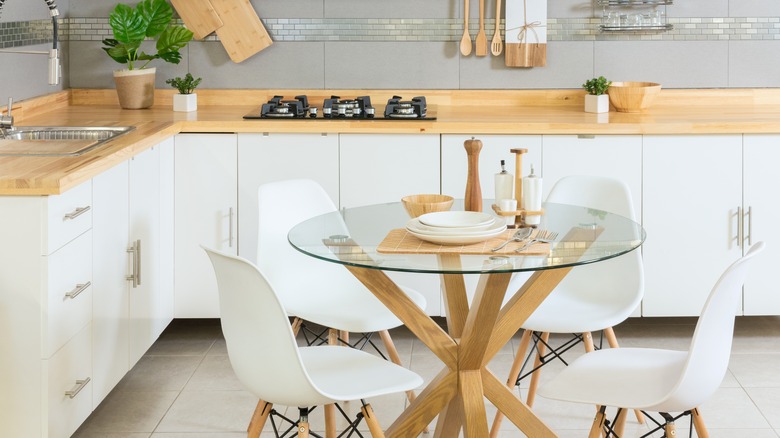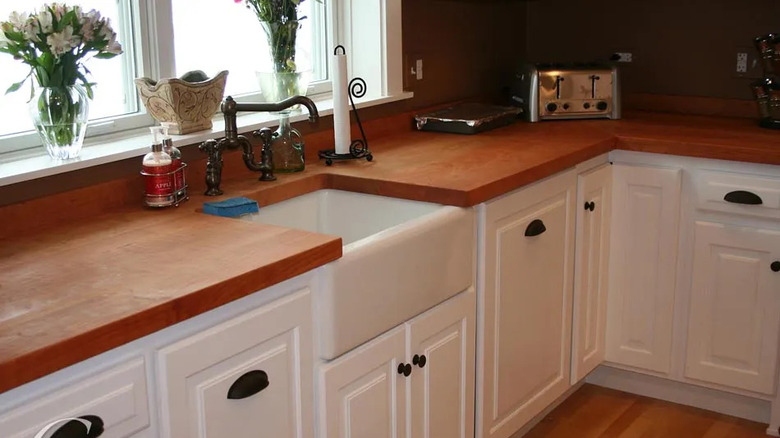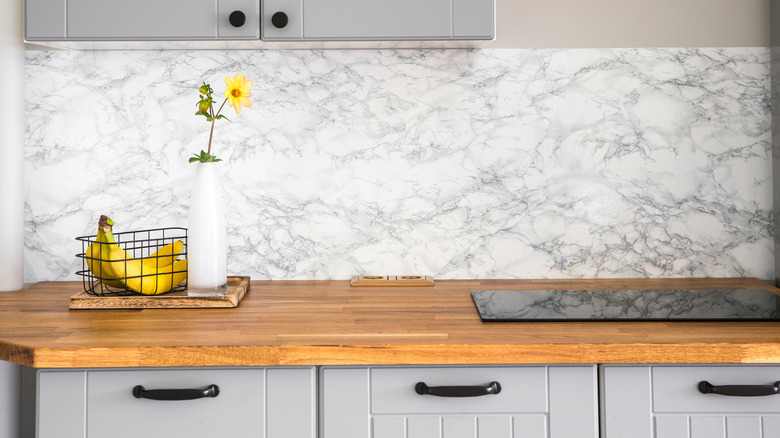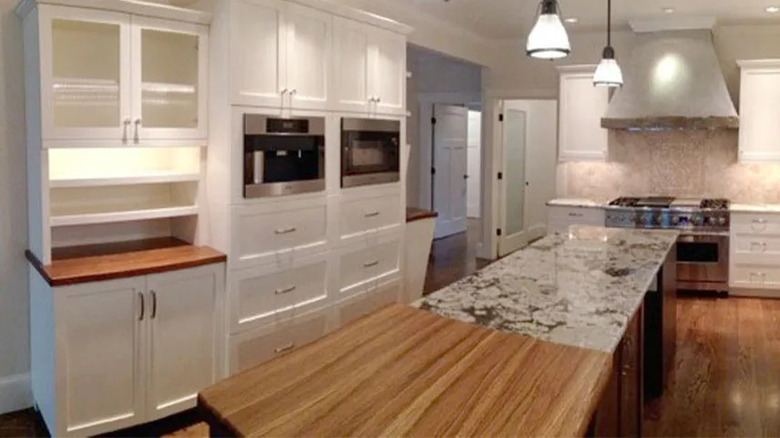The Top-Rated Wood Countertop Materials For Every Type Of Kitchen
Wood countertops lend a degree of warmth and natural beauty to a kitchen that cannot be achieved with stone, concrete, and tile materials. Butcher block countertops feature short pieces of wood glued tightly together while flat grain countertops show the grain in wide planks of wood. Both types work well with numerous styles of kitchen decor, including farmhouse, French country, traditional, and modern. Although wood countertops require sealing and regular maintenance to make them food safe and water resistant, many homeowners willingly attend to the ongoing tasks that keep wood countertops in tip-top shape for years.
If you choose wood countertops for your kitchen, you'll want to make sure they're hard enough to withstand heavy use. For this reason, we've researched hardwoods that rank high on the Janka wood hardness scale, the industry standard that measures the density and durability of wood materials. Each type of wood we recommend offers hardness as well as distinctive visual appeal to make it a top-rated wood material for kitchen countertops.
Oak is a durable wood that stands up to active use
Oak is a strong and heavy hardwood that is frequently used for furniture and cabinetry that withstands wear and tear from active use. This durable quality makes oak a go-to wood for kitchen countertops. Red oak ranks 1290 on the Janka hardness scale while white oak is harder, boasting a rating of 1360. In addition to its strength, the dense nature of oak's wood grain makes it naturally resistant to the growth of mold and fungi. Oak is a light-colored wood, but don't be fooled by the names of oak types. Red oak does not always have a red hue, as the name refers to the tree's autumn leaf color. Additionally, the color of white oak can range from a pale, almost-white hue to a richer golden-brown color.
Oak countertops contribute to an airy but warm vibe in the kitchen. As a bonus, oak is a budget-friendly choice when you're shopping for wood countertops. However, you should be aware that oak wood is susceptible to water damage. For this reason, it's crucial to seal oak countertops in the kitchen, especially in the food-prep area and around the sink. For safety, you'll want to use a food-safe sealer like mineral oil, tung oil, walnut oil, beeswax, or linseed oil. Apply the oil every month in the first year. After that, you can oil the wood every few months or whenever it starts to look dry.
Maple wood offers strength along with the refined look of a tight grain
Maple wood is often classified as either hard maple or soft maple. For kitchen countertops, hard maple is the better choice. When it comes to durability, hard maple wood rates higher than oak, coming in at 1450 on the Janka wood hardness scale. The coloration of hard maple varies from almost white to reddish brown, and the grain tends to be straight, close, and fine. Maple countertops can be stained in hues to complement any kitchen decor. In addition to their attractive coloration and grain, maple countertops can last for 20 years or more.
After sealing the maple wood with a food-safe sealer, you can maintain your countertops by following a simple daily regimen. First, wipe away any food residue and stains. Then clean the surface with a mixture of white vinegar, salt, and lemon juice. A downside of using maple for countertops is that the color darkens over time when exposed to light. For this reason, you might want to install maple countertops in areas away from windows and strong sunlight.
Add warmth to any kitchen with the dark and elegant appearance of walnut countertops
If you're looking for a dark, warm, and dramatic vibe in your kitchen, you may want to explore walnut as a choice for wood countertops. It's a hardwood material that contributes both beauty and functionality to your space. Black walnut rates a score of 1010 on the Janka wood hardness scale while Peruvian walnut is harder, ranking at 1080. In addition to its hardness, walnut is a stable material that does not swell and shrink like some other woods do. While walnut countertops cost more than other types, many homeowners are willing to pay the price for the elegant style of walnut wood. The deep chocolate coloring and graceful grain of walnut contribute a high-end look to any kitchen.
With its rich coloration, walnut wood does not need a stain. Instead, a clear coat of mineral oil is enough to provide a food-safe sealant for the countertop. Re-apply the oil periodically to maintain the surface. On a daily basis, you can clean a walnut countertop by wiping it with dish soap and following up with a cleaning mixture of white vinegar, salt, and lemon juice.
Teak wood contains natural oils for a germicidal effect
Teak is the wood of the tectona grandis, a hardwood tree that is native to Asia. It has long been prized for its toughness and water resistance, making teak a wood of choice for boat building as well as outdoor patio furniture. Teak receives a rating of 1155 on the Janka wood hardness scale, making it tough enough for use as a kitchen work surface. As an added bonus, teak contains compounds that kill bacteria. In fact, these compounds are extracted from the fruits of the tree and used to treat bacterial diseases in some countries. With its combination of durability, water resistance, and germicidal properties, teak is an excellent choice for kitchen countertops. Although it's more expensive than some other options, this wood may perform so well that you'll think it's worth the price.
Teak countertops can last for generations, as the wood does not warp, splinter, or crack. On top of that, teak resists the growth of mold and fungi as well as damage from termites. Due to its natural properties, you don't need to treat teak with a stain and sealer. However, you should oil the countertop regularly with a food-safe sealer like teak oil, tung oil, or linseed oil. It's okay to clean a teak countertop with soap and water. Additionally, you can deodorize with lemon juice and salt and remove stains with a paste made of baking soda and water.
Bamboo is a sustainable material that offers antimicrobial properties
Technically speaking, the bamboo plant is a grass, not a tree. However, bamboo material rates 1380 on the Janka wood hardness scale, making it harder than white oak. Bamboo demonstrates exceptional durability, resisting the dents and dings that might occur in a busy kitchen work area. It makes an attractive countertop with a light coloration and a variety of grain patterns. In addition to its good looks and toughness, bamboo offers advantages as an environmentally friendly material. The plant grows much faster than trees to increase the sustainability factor of bamboo, compared with hardwoods. As an added bonus, bamboo offers antimicrobial protection for food safety in the kitchen. Researchers find that the plant kills bacteria, including E. coli and S. aureus.
A bamboo countertop needs to be sealed with a food-safe product like mineral oil, beeswax, tung oil, or varnish. Repeat the application of sealant on a regular basis to make the bamboo non-porous. Sealing is especially important in areas where water might stand on the countertop, as bamboo swells when it absorbs water. Additionally, bamboo will develop visible scratches if you slice and chop foods directly on its surface. If scratches appear, you can remove them by sanding the bamboo and reapplying a sealant.
Cherry is a strong hardwood with a lovely color for your kitchen countertops
Due to its rich coloration and artful grain patterns, people have been making furniture and household objects from cherry wood since the time of ancient Greeks and Romans. If you want to bring the elegant look of fine furniture into your kitchen decor, cherry countertops might be a good option. American cherry receives a rating of 950 on the Janka wood hardness scale, indicating that it's softer than oak, maple, bamboo, teak, and walnut. The relative softness of American cherry means that it is more prone to dents than other hardwoods. However, Brazilian cherry (a.k.a. jatoba) scores a hardness rating of 2820, making it one of the toughest woods available. For a kitchen countertop, Brazilian cherry is a better choice than American cherry. Both types of cherry wood lend a warm reddish brown color along with a beautiful grain pattern to elevate the aesthetic appeal of any kitchen space.
Cherry countertops must be sealed with a food-safe sealant to make them water resistant and durable. After the countertop is sealed, re-apply mineral oil once a month to maintain the beauty of the wood. Instead of slicing and chopping foods on the countertop, it's a good idea to use a cutting board. This practice will prevent damage to the cherry wood.
Butcher block countertops made from birch are a popular choice for contemporary kitchens
In contemporary kitchens, the light and airy look of birch wood countertops fits right in with the modern aesthetic. Birch is an ideal wood for the butcher block style of countertop where strips of wood in varying lengths are laminated and tightly glued together. Due to its close grain and subtle color variations, birch creates a lovely effect in a butcher block application. With a Janka rating of 1260, yellow birch demonstrates greater hardness than both walnut and American cherry woods. This quality makes it a good candidate for busy kitchen work areas. As an additional advantage, birch is a less expensive choice than some other woods that are typically used for butcher block countertops.
An unfinished birch countertop must be finished and sealed before use. Experts recommend mineral oil for food safety. You should oil all of the exposed surfaces and edges of a new countertop every day for a week. After that, you can maintain the countertop by re-applying the oil once a month.
Mahogany countertops lend a tasteful style to elegant kitchens
The rich look of mahogany wood is associated with elegant interiors and fine furniture. Used as a countertop material, mahogany makes a sophisticated statement in your kitchen decor. Although it is classified as hardwood, some types of mahogany are softer than other woods. African mahogany is relatively soft, rating 860 on the Janka wood hardness scale. Similarly, Honduran mahogany (also known as genuine mahogany) rates a hardness score of 900. However, Sapele mahogany ranks 1510, and Santos mahogany comes in at 2200 on the scale. Consequently, those two types of mahogany exhibit greater hardness than white oak, birch, and hard maple. In a kitchen countertop application, the harder mahogany types would be the preferable choices.
Mahogany is prized for its deep tones and beautiful wood grain that sometimes resembles interlacing ribbons of color. Over time the color darkens, developing a richer hue that adds character to the countertop. To seal a mahogany countertop, you'll want to start with a thorough, food-safe finish of organic beeswax, mineral oil, or tung oil. For continuing maintenance, you can clean the countertop with diluted dish soap or white vinegar. Re-apply the oil sealer on a regular basis to keep the mahogany wood in good condition.
The distinctive grain of zebrawood adds a decorative element to your kitchen countertops
Zebrawood (a.k.a. zebrano) comes from a tree that is native to West Africa. Its grain is unique, showing variations in light and dark wood tones that form stripes reminiscent of zebra stripes. These wood grain patterns give zebrawood a distinctive presence in any interior space, and a kitchen countertop made from zebrawood can become a focal point in your decor scheme. This wood rates high on the Janka hardness scale, with some species scoring 1830 while others rank at 1575. With this level of hardness, a zebrawood countertop resists dents and scratches from heavy use.
A flat grain application shows off the beauty of zebrawood's contrasting colors and striped grain. This is preferable to an end-grain butcher block type of counter where the stripes in the wood are not so visible. Due to its porous texture, zebrawood is susceptible to water damage. Consequently, it should be thoroughly finished with a food-safe sealant. Experts recommend mineral oil. Be aware that you should re-apply the oil regularly to keep the wood from drying out.









